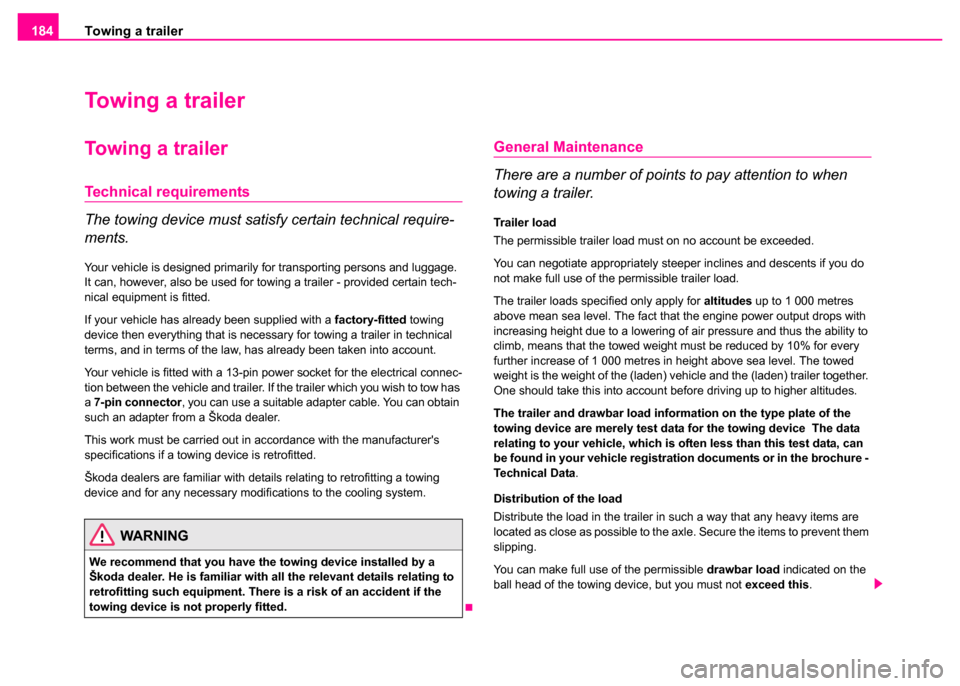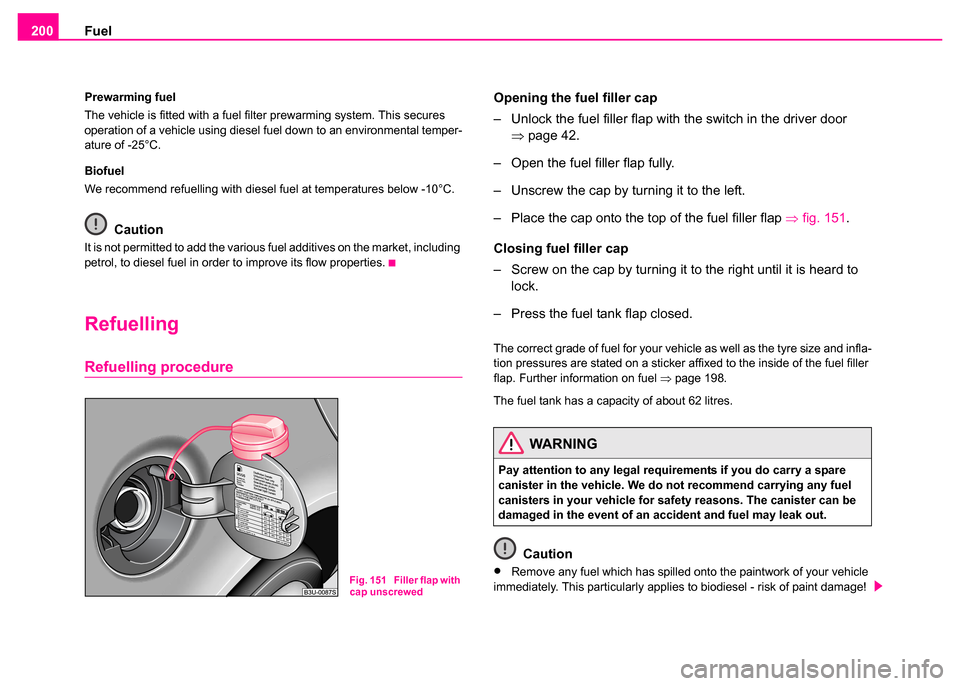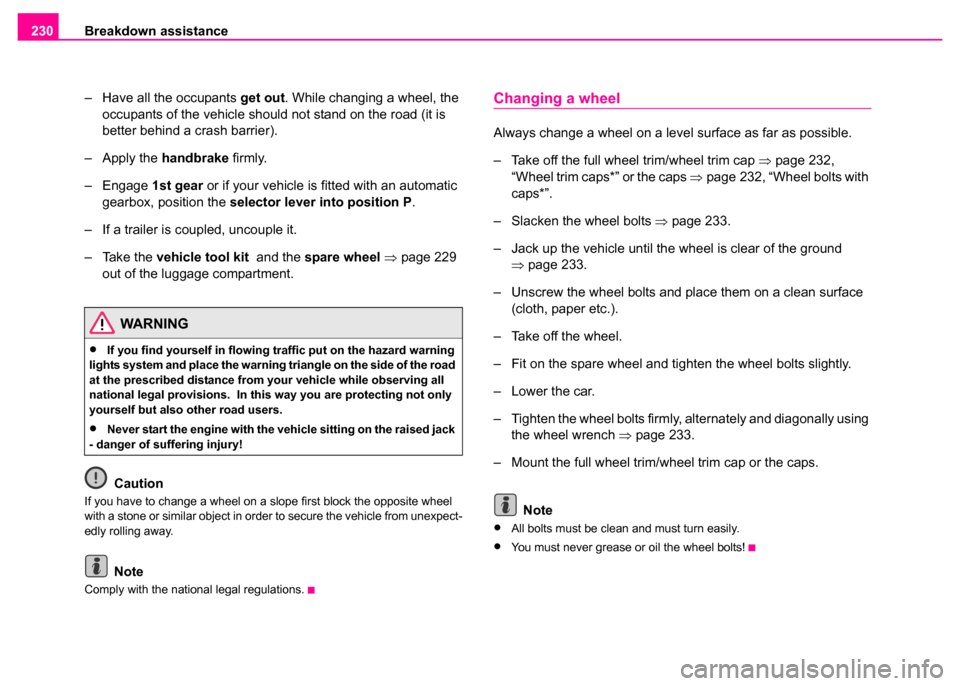ECU SKODA SUPERB 2003 1.G / (B5/3U) User Guide
[x] Cancel search | Manufacturer: SKODA, Model Year: 2003, Model line: SUPERB, Model: SKODA SUPERB 2003 1.G / (B5/3U)Pages: 259
Page 83 of 259

Seats and Stowage
82
– Pull the seat belt tight in direction of arrow ⇒page 81,
fig. 66 .
Stowing
– Close the cover for the through-loading bag in the boot.
– Carefully fold the through-loading bag together (approx. 11 cm packet).
– Close the cover in the interior of the car.
– Move the armrest back into its original position.
Note
Never fold the though-loading bag together if it is moist.
The cool box in the armrest of rear seats*
Using the system
The contents of the cool box is cooled to a temperature of about
20 °C below the ambient temperature, but to a maximum of
approx.+ 5 °C.
Opening and Closing
– Pull the handle ⇒fig. 67 and pull the lid downwards.
– Open up the lid of the cool box upwards until it is heard to lock.
Switching on and off
– The cooling action of the cool box is switched on and off using switch ⇒fig. 67 . It is signalised by the lighting up of the
indicator light on the switch.
WARNING
After placing items into the through-loading bag, you must secure
the bag with the belt .
AC
AAFig. 67 Cool box
AA
Page 86 of 259

Seats and Stowage85
Using the systemSafetyDriving TipsGeneral MaintenanceBreakdown assistanceTechnical Data
CargoFlex folding box*
Lowering and securing folding box
You can transport the folding box in two different positions - in the
transport position against the partition ⇒fig. 71 of the luggage
compartment, or in the ready position lowered onto the floor of
the luggage compartment ⇒ fig. 72.
Lowering folding box in to the ready position
– Pull the snap handle in direction of arrow 1 ⇒ fig. 71 . The
folding box is lowered to just above the floor of the luggage
compartment.
– Press the folding box at the arrow positions 2 ⇒ fig. 72 onto
the floor of the luggage compartment until it locks in place. If
correctly locked, the snap handle moves back into its initial
position (the top red surface of the handle is not visible).
Securing folding box in the transport position against
partition of luggage compartment
– Lower the folding box into the ready position ⇒page 87.
– Pull the snap handle in direction of arrow 1 ⇒ page 85, fig. 71 .
The folding box is raised up from the luggage compartment
floor.
– Raise and press the folding box against the partition of the luggage compartment, it is secured audibly in this way in the
transport position. If correctly locked, the snap handle moves
back into its initial position (the top red surface of the handle
is not visible).
Opening folding box ⇒page 86.
Fig. 71 Folding box:
Transport position
Fig. 72 Folding box:
ready position
Page 87 of 259

Seats and Stowage
86
Caution
The parts of the folding box can be damaged if handled roughly or in an
unprofessional way.
Opening folding box
You can transport the opened folding box in the secured end or
middle position against the partition of the luggage compartment.
Opening folding box
– Lower the folding box into the ready position ⇒page 85.
– Press the button marked “PUSH” ⇒page 86, fig. 73 .
– Grasp the folding box at the handle and push it in direction of arrow 1 against the partition of the luggage compartment
into the secured position. The lock below the button must be
heard to engage. If correctly locked, the button marked
“PUSH” moves back into its initial position.
– Raise the lid in direction of arrow 2 ⇒ page 86, fig. 74 .
Fig. 73 Luggage
compartment: folding
box
Fig. 74 Opening
folding box
AB
AA
AB
Page 88 of 259

Seats and Stowage87
Using the systemSafetyDriving TipsGeneral MaintenanceBreakdown assistanceTechnical Data
– Press on the bottom part of the handle and open the
compartments in the direction of arrow 3. The compartment
wall must be heard to engage in the slot in the bottom part of
the box.
Moving folding box into secured middle position
– Press on the button marked “PUSH” ⇒page 86, fig. 74
and carefully push the folding box into the secured middle
position. If correctly locked, the button marked “PUSH” is
moved back into its initial position. You can now use the space
which has become available for stowing further items of
luggage.
Caution
•The parts of the folding box can be damaged if handled roughly or in
an unprofessional way.
•The maximum weight of goods to be loaded should not exceed 25
kg.
Lowering folding boxAC
AD
AD
Fig. 75 Lowering
folding box
Fig. 76 Securing
folding box
Page 89 of 259

Seats and Stowage
88
– Press the bottom part of the handle ⇒page 87, fig. 75 and
fold the compartments in direction of arrow 1. The compart-
ments must be heard to engage in the lid.
– Close the lid in direction of arrow 2.
– Press on the button marked “PUSH” ⇒page 87, fig. 76
and push the folding box into the secured middle position.
– Once again press on the button marked “PUSH” and push the folding box carefully into the secured position against the
partition of the luggage compartment in direction of arrow
(ready position). If correctly locked, the button marked “PUSH” is moved back into its initial position.
You can leave the folding box in the ready position for use, or lower it into
the transport position ⇒page 85.
Caution
•The parts of the folding box can be damaged if handled roughly or in
an unprofessional way.
•First check for yourself whether the cover for the through-loading bag*
is closed before you lower the folding box into the ready position on the
partition of the luggage compartment ⇒page 81.
The roof luggage rack system
Description
Pay attention to the following points if you wish to transport luggage or
other items on the roof of your vehicle:
•Your car has streamlined rain channels integrated into the roof. For
this reason, it is not possible to use conventional roof racks. We therefore
recommend that you only use base roof bars from the Škoda Genuine
Accessories.
•These base roof bars are the supporting elements for a complete roof
bar system. Separate additional components are required for safety
reasons for transporting luggage, bikes, surfboards, skis and boats. All
these system components are available from Škoda Dealers.
Caution
•If you use other roof rack systems or if the roof bars are not properly
fitted, then any damage which may result to your car is not covered by the
warranty agreements. It is therefore essential to pay attention to the fitting
instructions supplied with the roof luggage rack system.
•On models fitted with a power sliding/tilting roof, ensure that the
opened sliding/tilting roof does not strike any items of luggage transported
on the roof.
For the sake of the environment
The increased aerodynamic drag results in a higher fuel consumption.
One should therefore take off the roof bar system after use.
AA
AB
AB
A3
AB
Page 158 of 259

Transporting children safely 157
Using the systemSafetyDriving TipsGeneral MaintenanceBreakdown assistanceTechnical Data
Transporting children safely
What you should know about
transporting children!
An introduction to the subject
Accident statistics have revealed that children are gener-
ally more safely transported on the rear seats than on the
front passenger seat.
Children younger than 12 years of age should normally travel on the rear
seat of the vehicle (take note of any national legal provisions which differ
from this). They should be secured there by means of a child restraint
system or by using the existing seat belts depending on their age, body
size and weight. The child seat should be mounted behind the front
passenger seat for safety reasons.
The physical principle of an accident does, of course, also apply to chil-
dren ⇒page 139. They differ from adults in that their muscles and bone
structure of children are not yet fully developed. Thus children are
exposed to increased risk of injury.
Children should be transported by using special child safety seats in order
to reduce this risk of injury.
Use only child safety seats which are officially approved and are suitable
for children and which comply with the ECE-R 44 Standard, which classi-
fies child safety seats into 5 groups ⇒page 161, “Classification of child
seats into groups”. Child restraint systems which have been tested for
conformity with ECE-R 44 have a non-detachable test seal (a large E
within a circle and below this the test number) attached to the seat. We recommend that you use child safety seats from the Škoda range of
genuine accessories. These child seats were developed and also tested
for use in Skoda vehicles. They fulfil the standard ECE-R 44.
Note
Any varying national legal regulations take priority over the information
provided in these instructions for use, or stated in this chapter.
Important safety informat
ion on using child safety
seats
Correct use of child safety seats considerably reduces the
risk of injury!
WARNING
Always comply with legal provis ions and instructions from the
relevant child safety seat manufacturer when installing and using
the child seat ⇒ in “Important safety information on using child
safety seats”.
WARNING
•All the occupants of the car - in particular children - must wear
a seat belt when the car is moving.
Page 185 of 259

Towing a trailer
184
Towing a trailer
Towing a trailer
Technical requirements
The towing device must satisfy certain technical require-
ments.
Your vehicle is designed primarily for transporting persons and luggage.
It can, however, also be used for towing a trailer - provided certain tech-
nical equipment is fitted.
If your vehicle has already been supplied with a factory-fitted towing
device then everything that is necessary for towing a trailer in technical
terms, and in terms of the law, has already been taken into account.
Your vehicle is fitted with a 13-pin power socket for the electrical connec-
tion between the vehicle and trailer. If the trailer which you wish to tow has
a 7-pin connector , you can use a suitable adapter cable. You can obtain
such an adapter from a Škoda dealer.
This work must be carried out in accordance with the manufacturer's
specifications if a towing device is retrofitted.
Škoda dealers are familiar with details relating to retrofitting a towing
device and for any necessary modifications to the cooling system.
General Maintenance
There are a number of points to pay attention to when
towing a trailer.
Trailer load
The permissible trailer load must on no account be exceeded.
You can negotiate appropriately steeper inclines and descents if you do
not make full use of the permissible trailer load.
The trailer loads specified only apply for altitudes up to 1 000 metres
above mean sea level. The fact that the engine power output drops with
increasing height due to a lowering of air pressure and thus the ability to
climb, means that the towed weight must be reduced by 10% for every
further increase of 1 000 metres in height above sea level. The towed
weight is the weight of the (laden) vehicle and the (laden) trailer together.
One should take this into account before driving up to higher altitudes.
The trailer and drawbar load information on the type plate of the
towing device are merely test data for the towing device The data
relating to your vehicle, which is often less than this test data, can
be found in your vehicle registration documents or in the brochure -
Technical Data.
Distribution of the load
Distribute the load in the trailer in such a way that any heavy items are
located as close as possible to the axle. Secure the items to prevent them
slipping.
You can make full use of the permissible drawbar load indicated on the
ball head of the towing device, but you must not exceed this.
WARNING
We recommend that you have the towing device installed by a
Škoda dealer. He is familiar with all the relevant details relating to
retrofitting such equipment. There is a risk of an accident if the
towing device is not properly fitted.
Page 201 of 259

Fuel
200
Prewarming fuel
The vehicle is fitted with a fuel filter prewarming system. This secures
operation of a vehicle using diesel fuel down to an environmental temper-
ature of -25°C.
Biofuel
We recommend refuelling with diesel fuel at temperatures below -10°C.
Caution
It is not permitted to add the various fuel additives on the market, including
petrol, to diesel fuel in order to improve its flow properties.
Refuelling
Refuelling procedure
Opening the fuel filler cap
– Unlock the fuel filler flap with the switch in the driver door
⇒page 42.
– Open the fuel filler flap fully.
– Unscrew the cap by turning it to the left.
– Place the cap onto the top of the fuel filler flap ⇒fig. 151.
Closing fuel filler cap
– Screw on the cap by turning it to the right until it is heard to lock.
– Press the fuel tank flap closed.
The correct grade of fuel for your vehicle as well as the tyre size and infla-
tion pressures are stated on a sticker affixed to the inside of the fuel filler
flap. Further information on fuel ⇒page 198.
The fuel tank has a capacity of about 62 litres.
Caution
•Remove any fuel which has spilled onto the paintwork of your vehicle
immediately. This particularly applies to biodiesel - risk of paint damage!Fig. 151 Filler flap with
cap unscrewed
WARNING
Pay attention to any legal requirements if you do carry a spare
canister in the vehicle. We do not recommend carrying any fuel
canisters in your vehicle for safety reasons. The canister can be
damaged in the event of an accident and fuel may leak out.
Page 231 of 259

Breakdown assistance
230
– Have all the occupants get out. While changing a wheel, the
occupants of the vehicle should not stand on the road (it is
better behind a crash barrier).
– Apply the handbrake firmly.
– Engage 1st gear or if your vehicle is fitted with an automatic
gearbox, position the selector lever into position P .
– If a trailer is coupled, uncouple it.
– Take the vehicle tool kit and the spare wheel ⇒ page 229
out of the luggage compartment.
Caution
If you have to change a wheel on a slope first block the opposite wheel
with a stone or similar object in order to secure the vehicle from unexpect-
edly rolling away.
Note
Comply with the national legal regulations.
Changing a wheel
Always change a wheel on a level surface as far as possible.
– Take off the full wheel trim/wheel trim cap ⇒page 232,
“Wheel trim caps*” or the caps ⇒page 232, “Wheel bolts with
caps*”.
– Slacken the wheel bolts ⇒ page 233.
– Jack up the vehicle until the wheel is clear of the ground ⇒page 233.
– Unscrew the wheel bolts and place them on a clean surface (cloth, paper etc.).
– Take off the wheel.
– Fit on the spare wheel and tighten the wheel bolts slightly.
– Lower the car.
– Tighten the wheel bolts firmly, alternately and diagonally using the wheel wrench ⇒page 233.
– Mount the full wheel trim/wheel trim cap or the caps.
Note
•All bolts must be clean and must turn easily.
•You must never grease or oil the wheel bolts!
WARNING
•If you find yourself in flowing traffic put on the hazard warning
lights system and place the warning triangle on the side of the road
at the prescribed distance from your vehicle while observing all
national legal provisions. In this way you are protecting not only
yourself but also other road users.
•Never start the engine with the vehicle sitting on the raised jack
- danger of suffering injury!
Page 236 of 259

Breakdown assistance235
Using the systemSafetyDriving TipsGeneral MaintenanceBreakdown assistanceTechnical Data
Changing a wheel
– Turn the wheel bolt which is farthest to the top fully out with
the hexagon socket in the screwdriver handle (car tool kit)
and place the bolt down on a clean surface ⇒page 234,
fig. 177 .
– Screw the assembly pin (car tool kit) into the vacant hole ⇒page 234, fig. 178.
– Unscrew the remaining wheel bolts as described above.
– Take off the wheel.
Fitting on wheel
– Push the spare wheel over the assembly pin.
– Screw in the wheel bolts and tighten them slightly with the aid
of the hexagon socket.
– Unscrew the assembly pin and screw in the remaining wheel bolt also slightly.
The wheel bolts must be clean and must turn easily.
The hexagon socket in the handle of the screwdriver makes it simpler to
fit on the wheel bolts. The reversible blade should be pulled out for this
step.
When fitting on unidirectional tyres, ensure that the tyres rotate in the
correct direction ⇒page 225.
Note
Do not use the hexagon socket in the handle of the screwdriver for slack-
ening or tightening the wheel bolts.
Securing wheels against being stolen
You need a special adapter for slackening the safety
wheel bolts.
– Pull off the full wheel trim/cap from the wheel hub or cap from
the safety wheel bolt.
– Push the adapter with its toothed side into the inner toothing of the safety wheel bolt right down in such a way
that only the outer hexagon is jutting out ⇒fig. 179.
– Push the wheel wrench fully onto the adapter .
– Slacken the wheel bolt, or tighten it firmly ⇒page 223.
– Reinstall the full wheel trim/wheel cap after removing the adapter or place the cap onto the safety wheel bolt.
Fig. 179 Safety wheel
bolt with adapter
AB
AA
AB